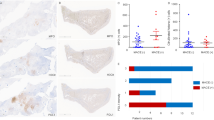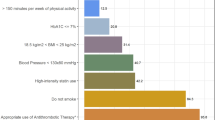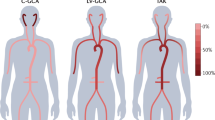Abstract
Several retrospective studies have described the clinical manifestation of peripheral artery occlusive disease (PAOD) in patients receiving nilotinib. We thus prospectively screened for PAOD in patients with chronic phase chronic myeloid leukemia (CP CML) being treated with tyrosine kinase inhibitors (TKI), including imatinib and nilotinib. One hundred and fifty-nine consecutive patients were evaluated for clinical and biochemical risk factors for cardiovascular disease. Non-invasive assessment for PAOD included determination of the ankle-brachial index (ABI) and duplex ultrasonography. A second cohort consisted of patients with clinically manifest PAOD recruited from additional collaborating centers. Pathological ABI were significantly more frequent in patients on first-line nilotinib (7 of 27; 26%) and in patients on second-line nilotinib (10 of 28; 35.7%) as compared with patients on first-line imatinib (3 of 48; 6.3%). Clinically manifest PAOD was identified in five patients, all with current or previous nilotinib exposure only. Relative risk for PAOD determined by a pathological ABI in first-line nilotinib-treated patients as compared with first-line imatinib-treated patients was 10.3. PAOD is more frequently observed in patients receiving nilotinib as compared with imatinib. Owing to the severe nature of clinically manifest PAOD, longitudinal non-invasive monitoring and careful assessment of risk factors is warranted.
This is a preview of subscription content, access via your institution
Access options
Subscribe to this journal
Receive 12 print issues and online access
$259.00 per year
only $21.58 per issue
Buy this article
- Purchase on Springer Link
- Instant access to full article PDF
Prices may be subject to local taxes which are calculated during checkout
Similar content being viewed by others
References
Kantarjian H, Shah NP, Hochhaus A, Cortes J, Shah S, Ayala M et al. Dasatinib versus imatinib in newly diagnosed chronic-phase chronic myeloid leukemia. New Engl J Med 2010; 362: 2260–2270.
Saglio G, Kim DW, Issaragrisil S, le Coutre P, Etienne G, Lobo C et al. Nilotinib versus imatinib for newly diagnosed chronic myeloid leukemia. New Engl J Med 2010; 362: 2251–2259.
Branford S, Kim DW, Soverini S, Haque A, Shou Y, Woodman RC et al. Initial molecular response at 3 months may predict both response and event-free survival at 24 months in imatinib-resistant or -intolerant patients with Philadelphia chromosome-positive chronic myeloid leukemia in chronic phase treated with nilotinib. J Clin Oncol 2012; 30: 4323–4329.
Larson RA, Hochhaus A, Hughes TP, Clark RE, Etienne G, Kim DW et al. Nilotinib vs imatinib in patients with newly diagnosed Philadelphia chromosome-positive chronic myeloid leukemia in chronic phase: ENESTnd 3-year follow-up. Leukemia 2012; 26: 2197–2203.
Hirsch AT, Haskal ZJ, Hertzer NR, Bakal CW, Creager MA, Halperin JL et al. ACC/AHA 2005 Practice Guidelines for the management of patients with peripheral arterial disease (lower extremity, renal, mesenteric, and abdominal aortic): a collaborative report from the American Association for Vascular Surgery/Society for Vascular Surgery, Society for Cardiovascular Angiography and Interventions, Society for Vascular Medicine and Biology, Society of Interventional Radiology, and the ACC/AHA Task Force on Practice Guidelines (Writing Committee to Develop Guidelines for the Management of Patients With Peripheral Arterial Disease): endorsed by the American Association of Cardiovascular and Pulmonary Rehabilitation; National Heart, Lung, and Blood Institute; Society for Vascular Nursing; TransAtlantic Inter-Society Consensus; and Vascular Disease Foundation. Circulation 2006; 113: e463–e654.
Writing Committee to Develop Clinical Data Standards for Peripheral Atherosclerotic Vascular D Creager MA, Belkin M, Bluth EI, Casey DE Jr., Chaturvedi S et al2012 ACCF/AHA/ACR/SCAI/SIR/STS/SVM/SVN/SVS key data elements and definitions for peripheral atherosclerotic vascular disease: a report of the American College of Cardiology Foundation/American Heart Association Task Force on Clinical Data Standards (Writing Committee to Develop Clinical Data Standards for Peripheral Atherosclerotic Vascular Disease). Circulation 2012; 125: 395–467.
Aichberger KJ, Herndlhofer S, Schernthaner GH, Schillinger M, Mitterbauer-Hohendanner G, Sillaber C et al. Progressive peripheral arterial occlusive disease and other vascular events during nilotinib therapy in CML. Am J Hematol 2011; 86: 533–539.
Le Coutre P, Rea D, Abruzzese E, Dombret H, Trawinska MM, Herndlhofer S et al. Severe peripheral arterial disease during nilotinib therapy. J Natl Cancer Inst 2011; 103: 1347–1348.
Quintas-Cardama A, Kantarjian H, Cortes J . Nilotinib-associated vascular events. Clin Lymphoma Myeloma Leuk 2012; 12: 337–340.
Tefferi A, Letendre L . Nilotinib treatment-associated peripheral artery disease and sudden death: yet another reason to stick to imatinib as front-line therapy for chronic myelogenous leukemia. Am J Hematol 2011; 86: 610–611.
Rooke TW, Hirsch AT, Misra S, Sidawy AN, Beckman JA, Findeiss LK et al2011 ACCF/AHA focused update of the Guideline for the Management of Patients With Peripheral Artery Disease (updating the 2005 guideline): a report of the American College of Cardiology Foundation/American Heart Association Task Force on Practice Guidelines. J Am Coll Cardiol 2011; 58: 2020–2045.
Giles FJ, Mauro MJ, Hong F, Ortmann C-E, McNeill C, Woodman RC et al. Rates of peripheral arterial occlusive disease in patients with chronic myeloid leukemia in the chronic phase treated with imatinib, nilotinib, or non-tyrosine kinase therapy: a retrospective cohort analysis. Leukemia 2013; e-pub ahead of print 5 March 2013 doi:10.1038/leu.2013.69.
Levato L, Cantaffa R, Kropp M, Magro D, Piro E, Molica S . Progressive peripheral arterial occlusive disease and other vascular events during Nilotinib therapy in chronic myeloid leukemia: A single institution study. Eur J Haematol 2013; e-pub ahead of print 18 March 2013 doi:10.1111/ejh.12096.
Orphanos GS, Ioannidis GN, Ardavanis AG . Cardiotoxicity induced by tyrosine kinase inhibitors. Acta Oncol 2009; 48: 964–970.
Agostino NM, Chinchilli VM, Lynch CJ, Koszyk-Szewczyk A, Gingrich R, Sivik J et al. Effect of the tyrosine kinase inhibitors (sunitinib, sorafenib, dasatinib, and imatinib) on blood glucose levels in diabetic and nondiabetic patients in general clinical practice. J Oncol Pharm Pract 2011; 17: 197–202.
Fitter S, Vandyke K, Schultz CG, White D, Hughes TP, Zannettino AC . Plasma adiponectin levels are markedly elevated in imatinib-treated chronic myeloid leukemia (CML) patients: a mechanism for improved insulin sensitivity in type 2 diabetic CML patients? J Clin Endocrinol Metab 2010; 95: 3763–3767.
Gologan R, Constantinescu G, Georgescu D, Ostroveanu D, Vasilache D, Dobrea C et al. Hypolipemiant besides antileukemic effect of imatinib mesylate. Leuk Res 2009; 33: 1285–1287.
Lassila M, Allen TJ, Cao Z, Thallas V, Jandeleit-Dahm KA, Candido R et al. Imatinib attenuates diabetes-associated atherosclerosis. Arterioscler Thromb Vasc Biol 2004; 24: 935–942.
Alzamora MT, Fores R, Baena-Diez JM, Pera G, Toran P, Sorribes M et al. The peripheral arterial disease study (PERART/ARTPER): prevalence and risk factors in the general population. BMC Public Health 2010; 10: 38.
Lamina C, Meisinger C, Heid IM, Lowel H, Rantner B, Koenig W et al. Association of ankle-brachial index and plaques in the carotid and femoral arteries with cardiovascular events and total mortality in a population-based study with 13 years of follow-up. Eur Heart J 2006; 27: 2580–2587.
Selvin E, Erlinger TP . Prevalence of and risk factors for peripheral arterial disease in the United States: results from the National Health and Nutrition Examination Survey, 1999-2000. Circulation 2004; 110: 738–743.
Larson RA, Le Coutre P, Reiffers J, Hughes TP, Saglio G, Edrich P et al. Comparison of nilotinib and imatinib in patients (pts) with newly diagnosed chronic myeloid leukemia in chronic phase (CML-CP): ENESTnd beyond one year. J Clin Oncol 2010; 28(suppl): abstr. 6501.
Ferri N, Carragher NO, Raines EW . Role of discoidin domain receptors 1 and 2 in human smooth muscle cell-mediated collagen remodeling: potential implications in atherosclerosis and lymphangioleiomyomatosis. Am J Pathol 2004; 164: 1575–1585.
Weisberg E, Manley PW, Breitenstein W, Bruggen J, Cowan-Jacob SW, Ray A et al. Characterization of AMN107, a selective inhibitor of native and mutant Bcr-Abl. Cancer Cell 2005; 7: 129–141.
Acknowledgements
FEN thanks Madeleine Etienne CRA for data collection.
Author information
Authors and Affiliations
Corresponding author
Ethics declarations
Competing interests
TDK, MS, PG, LL, HD, TM, HL, RL, WH, IB and BD declare no conflict of interest. DR received honoraria from Teva, Novartis and BMS. FEN was a consultant for Novartis, Ariad and Teva. He received lecture fees from BMS, Novartis, Ariad and Teva and received advisory board honoraria from Novartis, Ariad, Teva and Pfizer. GR received honoraria from Novartis, BMS, Pfizer and Roche. FJG is a consultant for and received research funding from Novartis. PDLC received honoraria from Novartis, BMS, Pfizer and Ariad. He also received research funding from Novartis.
Rights and permissions
About this article
Cite this article
Kim, T., Rea, D., Schwarz, M. et al. Peripheral artery occlusive disease in chronic phase chronic myeloid leukemia patients treated with nilotinib or imatinib. Leukemia 27, 1316–1321 (2013). https://doi.org/10.1038/leu.2013.70
Received:
Accepted:
Published:
Issue Date:
DOI: https://doi.org/10.1038/leu.2013.70
Keywords
This article is cited by
-
A Review of Cancer Immunotherapy Toxicity II: Adoptive Cellular Therapies, Kinase Inhibitors, Monoclonal Antibodies, and Oncolytic Viruses
Journal of Medical Toxicology (2022)
-
Predictive value of clinical examination parameters for cardiovascular adverse events during treatment of chronic myeloid leukemia with tyrosine kinase inhibitors
International Journal of Hematology (2022)
-
NOVEL-1st: an observational study to assess the safety and efficacy of nilotinib in newly diagnosed patients with Philadelphia chromosome-positive chronic myeloid leukemia in chronic phase in Taiwan
International Journal of Hematology (2022)
-
Multiple cell types contribute to the atherosclerotic lesion fibrous cap by PDGFRβ and bioenergetic mechanisms
Nature Metabolism (2021)
-
Arterial hypertension assessment in a population with chronic myeloid leukemia
Scientific Reports (2021)



